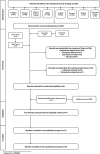Influence of reminder therapy for controlling bacterial plaque in patients undergoing orthodontic treatment: A systematic review and meta-analysis
- PMID: 29664334
- PMCID: PMC8191931
- DOI: 10.2319/111117-770.1
Influence of reminder therapy for controlling bacterial plaque in patients undergoing orthodontic treatment: A systematic review and meta-analysis
Abstract
Objective: To assess the scientific evidence regarding the influence of reminder therapy on plaque index, gingival index, and white spots in patients subjected to orthodontic treatment.
Materials and methods: Randomized clinical trials were searched in the electronic databases LILACS, PubMed, SciELO, Scopus, Web of Science, Embase, LIVIVO, and Cochrane Library. The databases OpenThesis and OpenGrey were used to capture the "gray literature," preventing selection and publication biases. The risk of bias was assessed by the Joanna Briggs Institute Critical Appraisal Checklist for Randomized Controlled Trials tool. The software Review Manager was used for the meta-analysis. The heterogeneity among studies was assessed through the I 2 statistic. A summary of the overall strength of evidence available was assessed using the Grades of Recommendations Assessment, Development, and Evaluation tool.
Results: A total of 332 records were found, from which only 7 articles met the inclusion criteria and were subjected to analysis. Reminder therapy showed improved scores for the plaque index (standardized mean difference = -1.22; 95% confidence interval = -2.03 to -0.42; P = .003) and the gingival index (standardized mean difference = 1.49; 95% confidence interval = -2.61 to 0.37; P = .009). Moreover, there was lower occurrence of white spots (relative risk = 0.53; 95% confidence interval = 0.38 to 0.74; P < .001) when reminder therapy was implemented.
Conclusions: According to the existing high-quality evidence, reminder therapy is a valuable strategy and may contribute to the reduction of plaque and gingival indices as well as to the lower occurrence of white spots in patients subjected to orthodontic treatment.
Keywords: Dental plaque; Gingival index; Orthodontics; Reminder systems; Smartphone; Text messaging; White Spots.
Figures




Comment in
-
Relevant Research from Orthodontic Journals.J Orthod. 2019 Mar;46(1):80-84. doi: 10.1177/1465312519831192. J Orthod. 2019. PMID: 31056061 No abstract available.
-
Letters From Our Readers.Angle Orthod. 2019 Jul;89(4):672. doi: 10.2319/0003-3219-89.4.672. Angle Orthod. 2019. PMID: 31219725 Free PMC article. No abstract available.
-
Letters From Our Readers.Angle Orthod. 2019 Jul;89(4):673-674. doi: 10.2319/0003-3219-89.4.673. Angle Orthod. 2019. PMID: 31219726 Free PMC article. No abstract available.
References
-
- Migliorati M, Isaia L, Cassaro A, et al. Efficacy of professional hygiene and prophylaxis on preventing plaque increase in orthodontic patients with multibracket appliances: a systematic review. Eur J Orthod. 2015;37:297–307. - PubMed
Publication types
MeSH terms
LinkOut - more resources
Full Text Sources
Other Literature Sources
Medical
Miscellaneous

